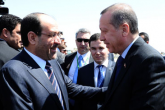A closer look at the past several decades through the Bin Laden episode helps us better understand the dynamics of America’s relationship with the Islamic world. America’s relationship with Bin Laden is a complex and messy story that dates back to the 1980s. One part of the story concerns the cost of America’s Middle East policies and the other part has to do with the “primitive” response in the form of terror given to the U.S. The region itself has paid the bigger price for the vicious cycle the U.S. created with its own hands to a large extent.
The second World Trade Center (WTC) attacks took place when the first Bush administration was facing political troubles following the disputed presidential elections in 2002, marking the beginning of a new era. Following the prosperous Clinton years, America was forced to face its “fear of terrorism.” This fear had reached the level of paranoia before the start of the new millennium. In contrast to the WTC attacks in 1993 this second round of attacks temporarily disoriented America’s social imagination and political psyche. Aside from a variety of political, economic, and social consequences, the September 11 attacks forged a cinematographic global actor: Osama bin Laden. The Osama figure became the symbol of America’s globalized fear. This figure grew ever larger over the past decade thanks to the overconsumption by American politics.
The first question is this: was the 9/11 attacks truly “shocking” to America? If we consider the ensuing ruckus and global developments, the answer is a clear yes. However, September 11 was not just a shock to America’s social imagination and political mind it was a confirmation of the fear of being destroyed. Let’s rewind the tape a little bit and go back 319 years in time to 1692. That year in Salem, Massachusetts, witchcraft trials were set up. A total of 140 people were accused of witchcraft and working with the Devil. Among those who were accused of associating with darkness and being a witch was a five-year old child. The court eventually decided to hang 19 of those accused. Three centuries after the Salem witch trials in 1692, awitchcraft court was set up in Manhattan three hours away from Salem: 19 real “fundamentalist attackers” proved America’s fears right. This time, it was not an imagined fear but a real destruction.
The most disturbing of the current fears in American social imagination is without a doubt the myth of the destruction of America, which owes its existence to an exodus. The first Puritans who stepped foot in New England repeated an old question: “who are we?” The response of the Puritans was very clear: “We are the people of Israel.” According to this view, the emigration of the first people to America was like the Jewish exodus from Egypt. Those fleeing from Europe were like those escaping Egypt. They were confined to the Atlantic Ocean like those stuck in Babylon and they found salvation by coming to America like those who later got on Noah’s arc. The historical and intellectual roots of the messianic character that manifested in post-9/11 American politics is embedded in this illusion of having being “saved”. Understanding the place this key concept holds in the American genesis helps in understanding the fear built over Bin Laden.
“American fears” were put aside momentarily with the killing of Bin Laden. However, it was not long before the talk of a new fear for the American without Osama: the “fear of retaliation.” This fear will likely be functional for quite some time. The neo-con politics has sought to shape America’s global policies according to a “blood feud” or a “dead or alive” approach. They have assumed the leading role in making the last ten years a lost decade for the globe as a whole in the face of global imbalances and injustice. With invasions of Afghanistan and Iraq, they paved the way for years of political instability instead of constructing a more just regional order at the expense of the peoples of


